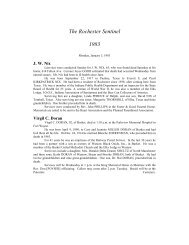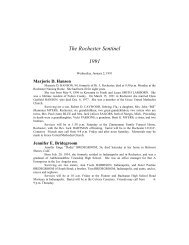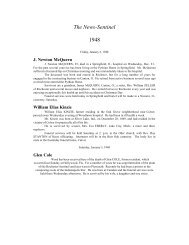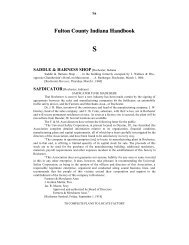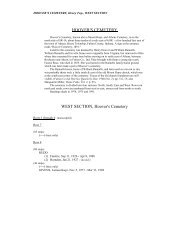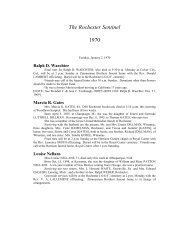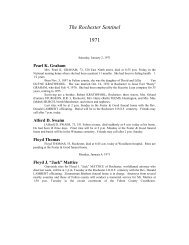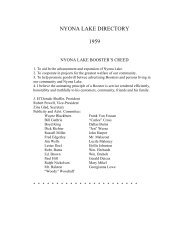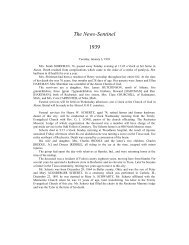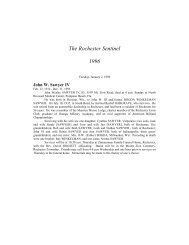Handbook N-P - Fulton County Public Library
Handbook N-P - Fulton County Public Library
Handbook N-P - Fulton County Public Library
You also want an ePaper? Increase the reach of your titles
YUMPU automatically turns print PDFs into web optimized ePapers that Google loves.
Pa<br />
O. L. Roberts, of Macy, and well known in this city, was in Peru Wednesday consulting<br />
with his attorneys, Cox & Andrews, in regard to a continuous rail joint which he had patented at<br />
Washington, D.C., Dec. 12, 1911. The number of the patent is 1,011,492. Expert railroad men<br />
have no small amount of praise for the patent which, if taken up by the railroads, will mean much<br />
to Mr. Roberts. Mr. Roberts got a patent on a street railroad tie in 1909. Mr. Roberts is a jeweler<br />
by trade.<br />
[Rochester Sentinel, Thursday, March 28, 1912]<br />
LOY’S IDEA MEETS WITH APPROVAL<br />
William Loy, the well-known inventor and general repairer of this city, came into<br />
additional fame as an inventor last month, when he sent in an article to the Popular Mechanics<br />
magazine, which dealt with a new invention. The particular idea advanced by the Rochester man<br />
was a device by which even a blind person could thread a sewing machine needle. It is made of a<br />
small piece of tin bent double, which holds a fine wire, with a hook on the end. The ends of the<br />
tin, which come almost together at one end slips over the needle and when it comes even with the<br />
needle opening the hook slips through. The thread is then placed in the hook and drawn back<br />
through. The simpleness of the device appealed to the Popular Mechanics people and they<br />
notified Mr. Loy that his article had been accepted. This meant that he got a dollar for his trouble<br />
and the next surprise came when he received a check for $5, accompanied by a letter telling him<br />
that he received second prize.<br />
The honor attached to his receiving this recognition is made greater when the fact is<br />
known that the magazine has a circulation of 315,000, and that there are thousands of contributors<br />
to that section.<br />
[Rochester Sentinel, Thursday, September 5, 1912]<br />
CARRIED OFF ANOTHER PRIZE<br />
Will Loy, the Rochester inventive genius and safe lock expert who has gained statewide<br />
fame in the past by his work along those lines and who several months ago sent in a simple device<br />
for threading a needle in the dark to the Popular Mechanics prize department for which he<br />
received first prize of $10, has just received word that he has been successful again. The latest<br />
thing to spring from his fertile brain was an easy way to make a twine holder. The device as<br />
explained by Mr. Loy is to take a funnel, which is to be suspended in the air and the ball placed in<br />
it with the end protruding through the spout. The Popular Mechanics thought so much of his idea<br />
that they awarded him second prize of $5. This is quite an honor as several thousand persons over<br />
the United States compete for these prizes every month.<br />
[Rochester Sentinel, Tuesday, December 3, 1912]<br />
FULTON COUNTY BOY INVENTS<br />
Geo. V. Dawson has installed a new electric humidor for his cigar case, which is the<br />
invention of a former <strong>Fulton</strong> county man, son of Amos Madary, who formerly lived seven miles<br />
south of the city. The son is now living in Traverse City, Mich., where his device, which is<br />
making him a fortune, is manufactured.<br />
It consists of a bath of water to which an ordinary electric bulb is immersed. The heat<br />
generated by the light evaporates the water, thus dampening the cigars. The adaptability of the<br />
humidor lies in the fact that it is automatic; that is, the light is turned on when a certain amount of<br />
vapor has been released. This is controlled by a sensitive double expansive brass disc, which cuts<br />
the current when the heat reaches a certain point, and which turns it on again when the temerature<br />
grows low. A thermometer attachment permits an adjustment from 65 to 110 degrees, depending<br />
upon the amount of water needed. The device is most ingenious and reflects credit upon the<br />
inventor, who will be remembered by many local people.<br />
[Rochester Sentinel, Friday, March 14, 1913]<br />
CITY LOSES BIG R.R. TIE FACTORY




